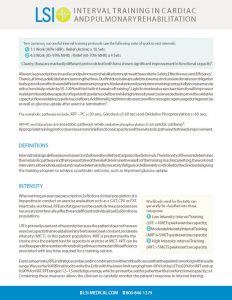The window of opportunity for cardiopulmonary clinicians to encourage their patients to make lasting lifestyle changes can often be very small. While patients are enrolled in a rehab program, it’s very important that clinicians push them while maintaining a safe environment. At times, it can be difficult to find a balance between Safety, Effectiveness and Efficiency (recognized as the S.E.E Principle) when working with cardiac and pulmonary patients.
Interval training is a great exercise method for cardiopulmonary patients. Interval training is defined as a set period of work followed by a set period of rest. Research has shown that interval training is a fast and efficient way to improve cardiovascular health as well as numerous metabolic pathways that contribute to many comorbidities often seen in these patients.
While interval training is a great exercise tool to be used in a supervised rehab setting, it is imperative that an initial exercise evaluation be completed before hand. The information obtained during this evaluation will determine if the patient should follow a Low Intensity, Moderate Intensity or High Intensity program.
We’ve created a two-page resource document that follows the FITT Principle for interval training:
- Frequency: 4 – 5 days/week
- Intensity: 40% – 90% HRR; RPE 12-15
- Time: 150 mins/week of moderate intensity exercise
- Type: Any modality
Visit our Educational Library to request a copy of this free resource document.

